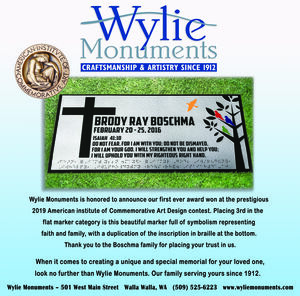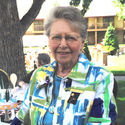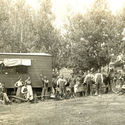Feeding the Crew in the Days Before Tractors
Barbara Cockburn Danforth shares stories of what harvest was like in the 1930s
July 19, 2018

Historic photo courtesy of Joe Drazen
This photo shows a cook wagon and crew during harvest at an unknown location, more than a century ago.
Last year, when I talked to ladies about harvest and cooking, I missed Barbara Cockburn Danforth, as she was not available. Her daughter, Susie Payne, shared that her mom was brought up in the days of mules pulling the harvest equipment, so I was looking forward to hearing about those times. As one who didn't live through those times, I'm always impressed at how much work they did and how little they complained.
Barbara told me her folks (Jack and Ada Cockburn) moved to Waitsburg in 1928, and they rented one of the Neace farms. The Neace family was one of the earlier settlers and seem to have a story all their own.
In the early 1930s, harvesting with the mules was quite different. Barbara said that her dad and the hired men got up about 4 a.m. in order to get the mules fed and harnessed before breakfast, which was at 6. There were 28 head of mules to deal with.
"Mom needed to get up then also in order to get the fire started in the wood stove to get the temperature up to bake the biscuits, which we had every day," Barbara said. "We also had meat, potatoes and eggs. Sometimes gravy depending on the meat.

"After breakfast, the men drove the mules to the field to hook on to the combine and mom and the hired girl started proceedings for dinner at noon, which was our big meal."
Garden vegetables had to be picked and prepared, the pies made and cake or cookies for supper as they tried to do all the oven work in the mornings when it was cooler. Bread was baked twice a week with hot rolls several times.
"We did have a complete kitchen in the basement so that helped keep it cooler," she said. "Bread was usually baked in the afternoon after it raised and the oven was free. Because the mules had to be driven in at noon to be fed and rested we had our big meal then."
For several years there were quite a few hired hands, so they had to take shifts eating at the table. Her mother also had two hired girls. Following dinner, the men rested out in the yard in the shade before going back to the field in the heat.
There was no electricity, but they had a Delco plant, which provided lights and nothing more. They had running water (gravity flow) a hot water heater and a bathroom.
Barbara said that the hired hands mostly came from skid row and were homeless. "There was a sandwich board in a tavern on lower Main St. in Walla Walla where farmers posted what type of workers they needed and unemployed men posted what skills they had," she said.
"I have quite a number of cancelled checks to the Dew Drop Inn and other places where [dad] did his interviewing of prospects," she added.
Water jugs were gallon jars covered with a padding of gunny sacks sewed on. They were soaked in the watering trough overnight and filled with cold spring water in the morning before the men went to the field.
They had a large ice box in the basement where they kept milk, butter and other perishables. The huge ice block was in the bottom. It was purchased at Bloor's Market in Waitsburg, covered with blankets, then newspaper, put in the trunk of the car. They hauled it home as fast as they could.
The family also rented a meat locker at Bloors for the beef they butchered. Their pork was all smoked or canned at home. They butchered 12 to 14 hogs each winter with the help of neighbors, who also got their share.

"The first night we dined on liver because it would not keep, and the second night, spareribs," Barbara said. "Bacon, ham and shoulders were smoked in their smoke house. The rest was canned, as there was no other way to preserve it." Even sausage was cooked in patties and put in jars and covered with grease and processed.
The family had milk cows to be milked twice a day, and a cream separator to separate the cream frim the milk. The cream was used liberally in or on top of a lot of the foods.
Barbara's mom sold five-gallon buckets of cream to Shady Lawn Creamery in Walla Walla. (It is still there, but is an antique shop today.) The money she received for this was HERS to spend, all three or four dollars of it.

Cleaning the separator was a chore which had to be done every day. Washing all the greasy parts, particularly the set of discs.
"We did not separate the cream at the nightly milking," Barbara said.
They also made their own cottage cheese, and Barbara remembers the time she pulled a pan of partially made cottage cheese off the counter and over her head.
Chickens were to be fed and eggs to be gathered. Chicken every Sunday had to start at the chopping block, and she remembers her mother's agility in doing that, then scalding and picking off the feathers.
They made their own lye soap, and Barbara remembers the time she put her arms up to her elbows in the lye. I can imagine the panic of trying to get it off as soon as possible and treat it with whatever remedy they had at the time---vinegar, butter or whatever.

Not only was the crew fed from the large garden, but everything was canned and preserved for the rest of the year. Barbara's mother canned hundreds of jars of vegetables and fruits – one year 600 quarts.
In 1936, Barbara's dad rented a farm in the Pleasant View district, 18 miles from their Alto home place. Then came the purchase of a tractor. Life changed, but they continued to do the harvest meals much the same, with big dinners at noon.
In 1954, Barbara and her husband, Bob Danforth, moved to the farm and started their long career there. In 1962, Bob decided it was not necessary to come in for dinner at noon, and they started the tradition of taking lunches to the field in lunch buckets in big coolers with thermal jugs of iced drinks.

As we talked, Barbara showed me the schedules for the meal planning for harvest from 1961, with additional lists of cakes to be made, kinds of cookies, salads, different sandwiches to plan for the lunches.
Long time friendships were acquired during those times, with the hired girls who helped with the cooking.
Bob and Barbara continued farming, and farming traditions, for many years thereafter.
It was fun to listen to Barbara reminisce about those "old farming days."





Reader Comments(0)